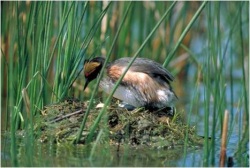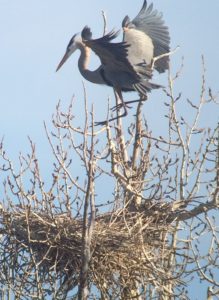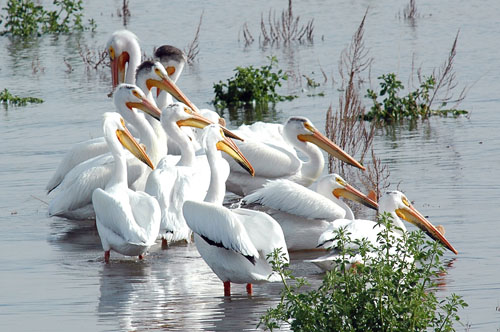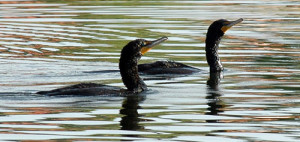Colonial Waterbirds
Colonial Waterbird Surveys in Montana

Many states in the western U.S., including Montana, recognize that understanding colonial waterbird distribution and populations is a priority to determine conservation status, identify potential threats, and develop conservation plans affecting these species’ habitats.
Colonial waterbirds are those that share two major characteristics: communal nesting in groups of a few individuals to a few thousand birds, and a reliance on water to sustain their food and nesting resources. There are 18 colonial waterbird species in Montana that regularly use our marsh vegetation, lush river habitats, trees, islands, and sandbars for nesting. However, 2016 marked the first year that evidence of nesting Cattle Egrets* was recorded in the state, raising the count total to 19 species.
Our most recent colonial waterbird conservation efforts include aerial mapping of Great Blue Heron Rookeries, and the discover of just the 5th known nesting location for American White Pelicans in Montana (at Ninepipe National Wildlife Refuge).
Check out those reports here: Aerial mapping of Great Blue Heron Rookeries 2020, 2019 Colonial Waterbird update from the field.
 Western Colonial Waterbird Survey
Western Colonial Waterbird Survey
From 2009 – 2011, A survey of colonial waterbirds (see species list below) was coordinated by U.S. Fish and Wildlife Service and implemented in our state by Montana Fish, Wildlife and Parks (FWP).
From 2012-2017, Montana Audubon worked collaboratively with FWP, Fred Tilly, and others including individual National Wildlife Refuge biologists, to continue the surveys in areas considered key sites. Efforts during 2018 and 2019 were limited to a few Important Bird Area surveys each year, but we hope to increase our efforts again in 2020 and into the future. Below are selected reports and a few species highlights.
For survey details see the Western Colonial Waterbird Survey Protocol.
Montana Audubon Colonial Waterbirds Poster
We recently summarized facts about this unique group of birds and our eight-year survey effort into a visually stunning, colonial waterbirds poster. Please request copies for your classroom or office by emailing aseaman@mtaudubon.org.
REPORTS:
- 2020 Aerial mapping of Great Blue Heron Rookeries
- 2019 Update from the Field
- 2017 Colonial Nesting Waterbird Report
- 2016 Final Report: Table 1, top-sites-2009-2016-selected-species, Table 2, 2016-sites-surveyed
- 2015 Colonial Nesting Waterbird Report
- 2014 Colonial Nesting Waterbird Report.
- 2011 Western Colonial Waterbird Report (all three years): Report, Appendix I data, Appendix II Species Account
- 2010 Western Colonial Waterbird Field season methods and results : Report, Appendix I, Appendix II
- 2009 Western Colonial Waterbird Field season methods and results is available: Report, Appendix I, Appendix II
For more information contact Allison Begley, abegley@mt.gov 406.444.3370
Priority species
- American White Pelican
- Clark’s Grebe
- Forster’s Tern
- Franklin’s Gull
- White-faced Ibis
- Black-crowned Night-heron
- Black Tern
- Caspian Tern
- Common Tern
Secondary species
- California Gull
- Double-crested Cormorant
- Ring-billed Gull
- Western Grebe
- Eared Grebe
- Red-necked Grebe
- Cattle Egret*
Great Blue Herons
The Great Blue Heron is a species of conservation concern in Montana. Their concern status is a result of a 2.2% annual population decline measured by Breeding Bird Surveys from 1966 – 2010. This colonial waterbird relies on intact rivers and stream side habitat to establish their nesting colonies, with one impact, it can affect many at one time. There are many rookery sites all over Montana and many can very difficult to find or to access. Currently, most of the surveys are conducted by aircraft which can be an expensive and challenging method. Flying over all the waterways of Montana within a year is simply unrealistic to carry out surveys on a regular basis.
That is why we have partnered with the Montana Natural Heritage Program to ensure a better state-wide coverage of annual heron rookery surveys. From the comfort of our own desk we used Google Earth’s aerial photography and satellite imagery to look over five sections of Important Bird Areas along major Montana Rivers. Believe it or not we found 94% of historic rookeries by using this survey technique! Now comes the part where we need to get into the field and confirm our findings. We are looking for citizen volunteers state-wide to help confirm potential new rookeries, populations, conservation opportunities, and threats to our Great Blue Herons in Montana.
Read more about our new Great Blue Heron citizen science program.
Great Blue Heron: Experimental Mapping Using Aerial Imagery
Pelicans and Cormorants
In May 2010, Montana Fish, Wildlife & Parks (FWP) finalized a 10-year management plan for the Missouri River, from Three Forks to Holter Lake Reservoir (near Helena). The plan, Final Upper Missouri River Reservoir Fisheries Management Plan (upper-missouri-fisheries-plan), suggests that American White Pelicans and Double-crested Cormorants are significantly impacting fisheries on Canyon Ferry Reservoir, and that the FWP Fisheries Bureau should “[w]ork with [the] FWP Wildlife Bureau and the U.S. Fish and Wildlife Service to determine the impacts of pelicans and cormorants to Canyon Ferry fish populations. Consider active bird management strategies if research shows significant impacts to fish populations.” FWP has indicated that keeping this item in the management plan only commits the agency to studying the impact of these birds on the fishery, stating that, “[a]ny proposal to implement population management measures will require an Environmental Assessment and provide opportunity for public comment. No management action will be taken without thorough research and evaluation of bird and fish interactions.”
Montana Audubon will continue to monitor this management recommendation. Montana Audubon’s comments on this issue are HERE.
More information on American White Pelicans and Double-crested Cormorants appears below.
 Pelicans
Pelicans
American White Pelicans are native birds that summer generally in the great plains and intermountain west, as far north as northern Alberta and Saskatchewan. They winter along the southern coasts of the United States through Central America.
Pelicans are colonial nesters, and breeding colonies typically are located on islands in lakes or reservoirs (to avoid mammalian predators). Colony sizes range up to 7,500 nests. The number of colonies, and the number of nests per colony, fluctuates from year to year. For example, Medicine Lake National Wildlife Refuge, located in northeastern Montana, had 1,690 nests in 1987, 3,370 nests in 1989, 2331 nests in 2016, and 2,901 in 2018.
Up until 2019, we knew of four primary nesting locations for the American White Pelican. Listed in order of largest colony size to smallest, they are Medicine Lake National Wildlife Refuge, Canyon Ferry Reservoir, Bowdoin National Wildlife Refuge and Arod Lakes. In the summer of 2019, we recorded evidence of nesting at just the 5th known location, Ninepipe National Wildlife Refuge, when one small chick was seen on an island.
Information on the types of food consumed by pelicans is limited. From anecdotal and circumstantial evidence, it is clear that pelicans will east many kinds of fish, as well as amphibians and crayfish. Specific prey species documented by direct observation or by finding fish tags include: carp, suckers, chub, trout, walleye, pike, and bigmouth buffalo. Montana Fish, Wildlife & Parks has looked at the diet of pelicans on Canyon Ferry Reservoir. Of the pelicans tested, the majority of their diet (upwards of 90%) was carp and/or crayfish. These pelicans occasionally also ate rainbow trout, and a few other species.
In Montana, American White Pelicans are considered a Species of Concern; these are native species that are at-risk due to declining population trends, threats to their habitats, restricted distribution, or other factors. This species is protected by the Migratory Bird Treaty Act of 1918. Pelicans declined in the mid-1900s because they were vulnerable to the spraying of DDT, endrin, and other organo-chlorides in agriculture, as well as widespread draining and pollution of wetlands. Montana has only four places in the state where pelicans breed: Medicine Lake National Wildlife Refuge, Bowdoin National Wildlife Refuge, Aarod Lake, and Canyon Ferry Reservoir. Recently they have been shown to be particularly susceptible to West-Nile Virus.
Our most recent Pelican information:
There are five known breeding locations for American White Pelican (AWPE) in Montana* Three are major colonies and two are much smaller. The year of the most recent nest counts vary by site, but nesting was documented at all 4 sites for the AWPE in 2019. Our most recent counts indicate that numbers are overall stable despite large fluctuations at some colonies, and that they are staying very close to the 2009 through 2015 average of 5810. The most recent colony counts include: Medicine Lake National Wildlife Refuge (in 2018, 2901 nests), Canyon Ferry Reservoir (in 2017, 1638 nests), Bowdoin National Wildlife Refuge (in 2018, 2,237 nests), Arod Lakes (in 2015, 150 nests) and Ninepipe National Wildlife Refuge (in 2019, 1 nest).
The AWPE typically nests in large colonies on an island or point that is relatively isolated from predators. The nests are shallow depressions scraped in the ground and lined with twigs and other debris. Where available, partial shade afforded by trees is preferred. Colony locations may vary from year to year depending on water levels and other factors. The timing of egg laying may vary among colonies, even those in close proximity. At Medicine Lake NWR during both seasons there were two sub-colonies, one on a large island and one on a long point from which predators were excluded with an electric fence. At the time of the surveys island nesting birds had only eggs while on the point the nests had well-developed chicks, one invariably much larger than the other, in nearly every nest. In subsequent years all nesting for the species at Medicine Lake was on the point only. The species is known to travel long distances at times to feed during the nesting period.
Productive (meaning active nests were documented) nesting colony survey dates for this species have ranged from 5/18 to 6/15 during the eight years of this study.
Note* – in 2019 we found Montana’s 5th breeding location for American White Pelicans at Ninepipe National Wildlife Refuge. Find that short report at the top of the page.
 Cormorants
Cormorants
Double-crested Cormorants are native birds that are distributed widely across North America. These cormorants nest near the ocean, as well as in the interior of the United States and Canada. They winter along the Atlantic, Pacific, and Gulf of Mexico coasts.
Cormorants are colonial nesters. They generally build their nests in trees, on cliff faces, or on islands. In Montana, they have been recorded nesting at over 40 sites, and they are occasionally recorded nesting in rookeries along-side of Great Blue Herons. Double-crested Cormorant colonies are much smaller than pelican colonies, and range between 5 and 1,200 nests in Montana. Our largest colonies are found at Bowdoin National Wildlife Refuge (the highest count of 1,200 nests), Ninepipe National Wildlife Refuge (a high-count of 167 nests), Medicine Lakes National Wildlife Refuge (a high-count of 291 nests), and Red Rock Lakes National Wildlife Refuge (a high-count of 225 nests).
These cormorants mainly eat fish, although they also eat amphibians and crustaceans. Adults eat an average of one pound per day, usually comprised of small (less than 6 inch) bottom dwelling or schooling “forage” fish. According to a 2006 study conducted on Canyon Ferry, Double-crested Cormorants ate the following percentages of different aquatic species: 44% stonecat, 13.2% trout, 13.2% suckers, 15.5% dace, 6.6% sculpins, and 7.7% crayfish. Summarizing this information, the diet of Canyon Ferry cormorants contained approximately 87% nongame fish and 13% game fish (trout).
In Montana, Double-crested Cormorants have no special conservation status. However, this species is protected by the Migratory Bird Treaty Act of 1918. Double-crested Cormorant numbers decreased in the 1960s due to the effects of DDT, and the 2014 National Audubon Climate Report lists them as climate threatened because 21% of its summer range, and 72% of its winter range are predicted to be stable through 2080.
Our most recent cormorant summary data:
The Double-crested Cormorant is a common breeding species throughout Montana. Nests consist of a platform of sticks in a tree or on the ground on an island. The DCCO often nests in tree colonies with herons or on the ground within large gull and pelican colonies. They generally breed at three years of age and nest in large or small colonies.
Nesting was documented at a total of 8 sites for the DCCO in 2016. One site, where the species has always nested in years surveyed, was not covered in 2016. The top three nesting sites were Bowdoin NWR with 491 nests, Canyon Ferry WPA with 215 and Freezout Lake with 173. The 2016 total for the four key sites was 999. These sites, all east of the Continental Divide and ranging from Freezout Lake WMA in Teton Co. to Medicine Lake in Sheridan Co., show a slight increase after the 2009-2011 period with some large annual fluctuations at individual sites. Productive nesting colony survey dates for this species have ranged from 5/3 to 7/13 during the eight years of this study.
More information about Double-crested Cormorants can be found at:
- To Kill a Cormorant: Are double-crested cormorants overrunning their niche—or simply recovering from centuries of suppression? Read the 2009 Natural History Magazine article.
- Montana Field Guide
- Conservation Status
- Cornell Lab of Ornithology
Colonial Waterbirds and Climate Change
Predicted changes in precipitation and temperature due to climate change indicate that wetland habitats colonial nesting birds are reliant upon will be reduced in area. Wetlands are predicted to become less capable of controlling flood waters, capturing sediment, and replenishing groundwater resources, which are ecosystem services they have historically provided. The prairie pothole region, which includes many of the shallow wetlands of eastern Montana, is expected to experience more drought conditions, and the resulting loss of wetlands could be dramatic. Further, many wetland systems are seasonal or semi-permanent, so increased rates of evaporation alone can cause these habitats to decline. Birds dependent on these shallow sites are particularly vulnerable such as the White-faced Ibis, Black-crowned Night Heron, and Clark’s Grebe.
In 2014 the National Audubon Society conducted a study that revealed 314 North American bird species were “threatened” or “endangered” by climate change, and this included 16 of Montana’s 18 waterbird species. Only two, Great Blue Heron and Snowy Egret could not be categorized because of a lack of specific data. Being designated as climate-threatened means that the species is expected to lose 50% of their range by 2080 and climate-endangered means that 50% loss could occur as soon as 2050. Six of Montana’s colonial waterbirds are threatened, while ten are endangered by climate change.
In 2019, National Audubon updated their climate science models and released the report, Surival by Degrees: 389 Species on the Brink. Using improved data analysis, and an enormous data set of over 140 million bird observations, they updated their projections of just how North America’s birds may be affected by climate. When it comes to Montana’s colonial waterbirds, climate change is expected to alter their preferred nesting habitat through drought, fire, and altered precipitation regimes. Fortunately, the majority of our waterbirds species are predicted to experience less severe effects in Montana, however, species like Hooded Grebe, Eared Grebe, and Franklin’s Gull are expected to be more affected, with a resulting decrease in their ranges within the state. Several species expected to be less affected, but never-the-less are predicted to see a slight decrease in range. These species include the Common Tern, Black Tern, Double-crested Cormorant, California Gull, Ring-billed Gull, Western Grebe, Clark’s Grebe, and Red-necked Grebe.
These and many more details about Montana’s birds and climate change from the 2019 report can be found HERE.